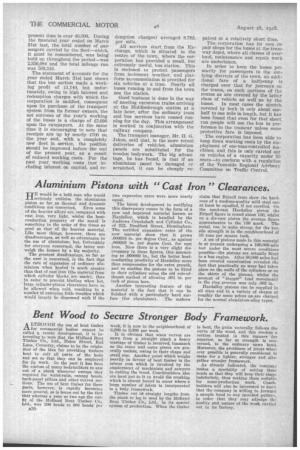Aluminium Pistons with "Cast Iron" Clearances.
Page 14

If you've noticed an error in this article please click here to report it so we can fix it.
JJE would be a bold man who would seriously criticise the aluminium piston so far as thermal and dynamic conditions are concerned. Even some of the heavier alloys are, compared with cast iron, very light, whilst the heatconducting property of the metal is something in the order of five times as good as that of the heavier material. Like most things, however, there are disadvantages, as well as advantages, in the use of aluminium, but, fortunately for everyone concerned, the latter outweigh the former by a big majority.
The greatest disadvantage, so far as the user is concerned, is the fact that the rate of expansion of ordinary aluminium when heated is much greater than that of cast iron (the material from which cylinder 'blocks ,are made), thus in order to prevent binding when hot, large cylinder-piston clearances have to be allowed when cold, resulting in a number of annoying little troubles which would largely be dispensed with if the
two expansion rates were more nearly equal. '
The latest development in rectifying this discrepancy comes in the form of a new and improved material known as Hardalloy, which is handled by the Andrews Crankshaft and Cylinder Co., of 312, Bradford Street, Birmingham. The certified expansion rates of the new material show that it grows .000018 in. per degree Cent., as against .000016 in. per degree Cent. for cast iron. Now there is a very slight discrepancy in these figures, this amounting to .000002 in., but the better heatconducting proclivity of Ilardalloy more than compensates for the extra growth, and so enables the pistons to be fitted to their cylinders using the old rule-ofthumb method of allowing .001 in. per inch of piston bore.
Another interesting feature of the material is the fact that it can be finished with a particularly hard surface (for aluminium). The makers claim that Brinell tests show the hardness of a medium-quality mild steel can at least be equalled, if not excelled. On the sand-cast Hardalloy piston the Brinell figure is round about 130, whilst on a die-cast piston the average figure approximates to the 150 mark. The metal, too, is quite strong, for the tensile strength is in the _neighbourhood of 18 tons per square inch.
A set of pistons made in this materiel is at present undergoing a 100,000-mile test underthe most severe conditions possible—the pistons are actually fitted to a bus engine. After 50,000 miles had been covered examination revealed the fact that practically no wear had taken place on the walls of the cylinders or on the skirts of the pistons, whilst the amount of "slogger" (end movement) in the ring grooves was only .002 in.
Hardalloy pistons can be supplied in all sizes and in a variety of shapes at roughly the same prices as. are charged for the normal aluminium-alloy types.
































